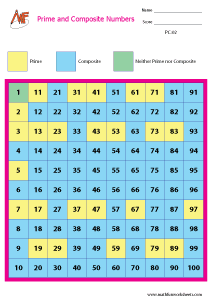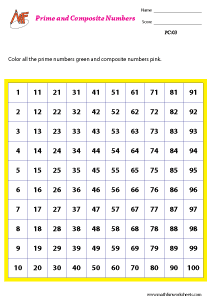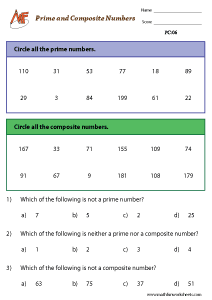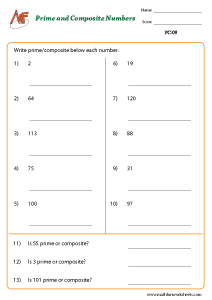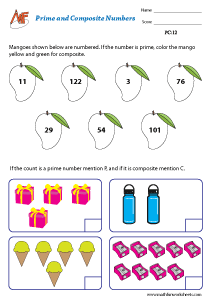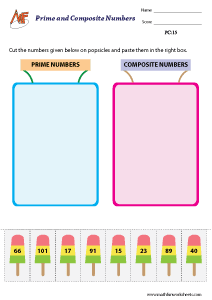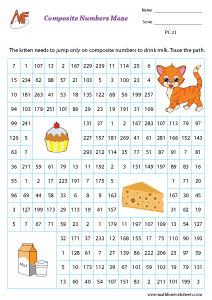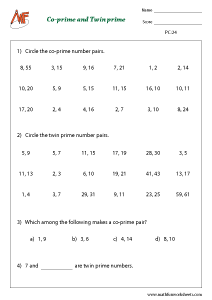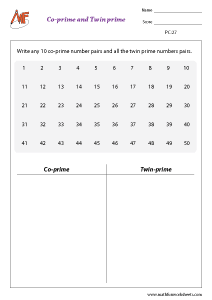- Home
- Numbers & Operations
- Prime and Composite Numbers
Browse by Topics
- English Worksheets
- Science Worksheets
- Kid's Corner
- Numbers & Operations
- Addition
- Subtraction
- Multiplication
- Division
- Decimals
- Place Value
- Roman Numerals
- Skip Counting
- Odd & Even Numbers
- Patterns
- Cardinal & Ordinal Numbers
- Rounding Numbers
- Estimation of Numbers
- Estimation of Time & Money
- Counting & Cardinality
- Comparing Numbers
- Ordering Numbers
- Fractions
- Prime & Composite Numbers
- Squares & Cubes
- Square & Cube Root
- Divisibility Rules
- Factors & Multiples
- Data Handling
- Algebra
- Ratio
- Least Common Factor
- Greatest Common Factor
- Percent Worksheets
- Proportion
- Order of Operations
- Scientific Notation
- Exponents
- Algebraic Expressions
- Evaluating Algebraic Expressions
- Simplifying Algebraic Expressions
- Graphing Lines
- Point Slope Form
- Two Point Form
- Two Intercept Form
- Equations
- Identifying Functions
- Evaluating Functions
- Function Table
- Domain and Range
- Trigonometric Charts
- Quadrants
- Polynomials
- Measurement
- Geometry
- Word Problems
Prime and Composite Numbers Worksheets
Here are more than 25 prime and composite number worksheets, carefully designed for grade 4 through grade 6 students. We will clearly discuss the concepts of prime, composite, co-prime, and twin prime numbers. We can classify all natural numbers as prime and composite.
Prime Numbers: Any natural number that has only two factors, the number itself and 1 is known as a prime number.
Eg. 1, 2, 3, 5,……11,……23,…..97,…
The number 3 has only two factors. That is, it is only divisible by 3 and 1. (Without leaving a remainder). Thus 3 is a prime number.
The number 2 is the smallest prime number. Interestingly, its the only even prime number which means all other prime numbers are odd.
Composite Numbers: Any natural number that can be divided by other natural numbers and with the number itself and 1 is a composite number.
Eg. 6, 8, 9,…..86,…99,…
With 1 and 6, the number 6 has other factors like 2 and 3. Thus the factors of 6 are 1, 2, 3, and 6 which makes 6 a composite number.
1 is the only number which is neither prime nor composite.
Twin primes: Prime number pairs which differ from each other by 2 are twin primes. Eg. 3 and 5, 11 and 13, 41 and 43…..
In the above shown pair of numbers, the difference between the numbers is 2.
Co-primes: Numbers that do not have any common factor other than 1 are called co-prime numbers. Eg. Number pairs 2 and 3, 3 and 4, 4 and 5…………17 and 23, 29 and 31,……..
29 and 31 are both twin primes and co-primes.
All twin primes are prime numbers, whereas all co-primes need not be prime numbers.
Prime and Composite Numbers worksheets free download pdf
Differentiate prime and composite numbers

Differentiate prime and composite numbers
Circle prime and composite numbers

Circle prime and composite numbers
Write prime / composite below each number

Write prime / composite below each number
Color prime and composite numbers

Color prime and composite numbers
Cut and paste prime / composite numbers

Cut and paste prime / composite numbers
Circle co-prime and twin prime numbers

Circle co-prime and twin prime numbers
Write co-prime and twin prime number pairs

Write co-prime and twin prime number pairs

